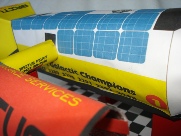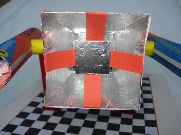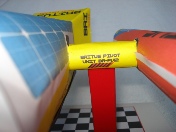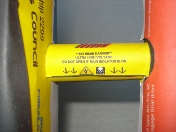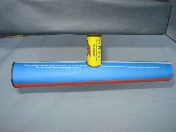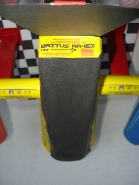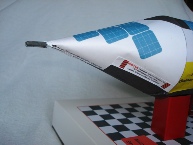
Formula X racing spaceships are fantastic things! Want to know more? Then read on…
If you have read either of the two books regarding Formula X spaceship racing, you may be wanting to know more. To this end, a 1:20 scale model of one of the spaceships has been created, the Britus ‘Isaac Newton’ machine, to be raced by reigning Formula X Galactic Champion Shas’olum during the 2299 racing season. Here, using photos of the model, you can find out how these incredible machines work with this visual aid as to how things go together to create an incredibly focused pure bred race machine. Formula X is is the fastest and most exciting motorsport in the history of human civilisation and the machines used feature incredible technology and capabilities. Click on any of the images here for a closer look.
Basic design
A racing spaceship is designed for one purpose, to fly from the start of a race to the finish as fast as possible, with no concessions to anything else. As a result, the design is very simple. The engine is housed within the main body, with the cockpit directly in front. The rear thruster is fed directly by the turbine unit behind the engine. The ship has a pair of outboard integrated turbine and thruster units, with thrusters front and rear that pivot left to right and swivel up and down, to allow the ship to gain or lose height and to turn left and right. The front thrusters fire to give reverse thrust for braking. This configuration is the most simple method to allow a spaceship to undertake basic manoeuvres. However, the set up makes for an incredibly loud and uncomfortable pilot cabin, so such a configuration would not be suitable for public use, hence why a Formula X racer is not legal for normal transporation.
Main Body
The main body of a racer houses the solar powered engine. The outer skin holds the solar cells, pictured here as the blue patterned squares. The reality is that the entire area shown here as the white sections are also solar cells. The blue cells are usually arranged in a different pattern, set up to suit the race the ship is flying. The engine is housed entirely within this section, directly behind the cockpit. At the rear of the main body, underneath the rear thruster unit, the ship has a tow facility, which is used for low speed manoeuvres, usually in the pit area or main hangar (see picture of the heatshield further down).
Rear Thruster
Feeding from fuel directly behind the engine, the thruster ejects power behind the ship to allow it to move forwards. Note the special heat resistant material lining on the inside of this component. A unusual aspect of the Britus design is the square shape, most turbines in Formula X are round, like one half of a ball.
Pivot Units
Pictured here are the two pivot units. These components are absolutely critical for the spaceship, and in terms of development cost, are by far the most expensive item on a racing spaceship, in terms of cost per meter of material. The units have to do so much work. Firstly, they support the huge outboard turbine/thruster units, that weigh in excess of two tons each. They also have to allow raw energy to pass through from the engine that power these units. The warning signs on the units are not there for fun…
Pivot units can last an entire season, however they are routinely checked after each flight to ensure there are no stress fractures or anything that indicates an imminent failure. If the pivot unit fails, the outboard turbine would detach, causing the ship to be instantly impossible to fly with potential fatal consequences for the pilot.
Outboard turbine and thruster units
To allow the spaceship to turn left, right, slow down and accelerate, the outboard side turbines have a critical role. Without these, the spaceship would not be able to turn around, or slow down. The turbines work by turning on the pivot units. To turn the ship left, the turbine/thruster units will pivot left, with thrust coming out of the rear. To gain height, the turbines move round on the pivots, with thrust provided to force the ship upwards. Reverse thrust is gained by the thruster firing out of the front unit. The concept is really simple, but despite this, is one of the greatest challenges for Formula X teams to get right for a ship, to gain the elusive ‘balance’. The responsiveness of the outboard units is incredibly fast, giving the pilot the ultimate control and the ability to change direction as fast as possible. Obviously, there are limits to how far the turbines can turn, otherwise they would hit the main body or cockpit.
Downforce Thrusters
A Formula X race team is ultimately concerned with achieving the highest speed around a celestial object. One vital aspect to this is to ensure the ship flies as close as possible to the surface of the object. As the planets or moons are invariably round in shape, due to the high power and speed a spaceship can travel, if it flies straight, it will always gain height. To ensure it stays close to the surface, a modern Formula X spaceship employs the use of downforce thruster units, of which there are two mounted on the roof. The amount of thrust these units emit depends on the course; racing over Deimos, one of the moons of Mars, requires very high downforce due to the small size of the moon, as there is less gravity to pull the ship in. On Earth, the high gravity of the planet means the ship does not require as much downforce. Getting this balance right is critical for the performance of the ship in race conditions.
Integrated Cockpit/Escape Pod
The cockpit of a modern Formula X racer is positioned as far forwards as possible, to allow the pilot the best possible view. The cockpit doubles up as an escape pod, which means it can eject from the main body in the event of a catastrophic failure of the ship. The escape pod has its own power source to allow it to land safely. At the very front of the cockpit, and indeed of the whole ship, is the data transmitter, to allow the pilot and ground crew to communicate with each other, which is a vital part of a racing team to ensure the pilot is kept up to date with developments. Obviously the broadcast frequency is secret and only known to the team and the race organisation.
Heatshield
To ensure safety for flying into Earth’s atmosphere, a spaceship requires a working
heatshield. The heat build-

